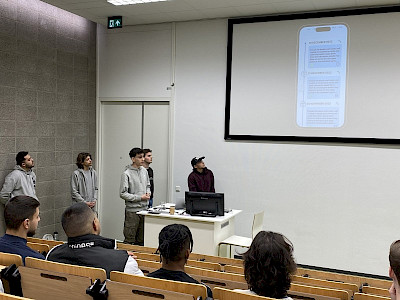The idea of the application originated with Tom Adams, a teacher in the teacher education program. He explains that his students are instructed to reflect a lot. About lessons they teach, activities they experience, but also about simple kitchen table conversations.
That reflecting is done, but according to Adams it can be done in a much more efficient way than it is done now. So he came up with the initiative to create a reflection app. "From our program, there is a need for a tool where students can reflect better," he says.
"When they reflect, they often do so only on the basis of formal things. But students also learn in the workplace in informal and unplanned ways. They never mention those reflections in their portfolios."
Collaboration
Adams joined forces for his idea with Arjan Groeneweg, teacher and coordinator at Fontys ICT. One provided some students from the teacher training program, the other sought out some ICT students.
"We had them work together in groups," Adams explains. "My students communicated to the ICT students what their wishes would be for an application in which to reflect. The ICT students then started working on that."
Within six weeks, two prototypes of the app were created by different groups. FLOT student Imane also worked on it. "In everyday life, you often don't think about reflecting. Usually you only write down reflections when you are working on your portfolio. You then only think back on an experience a few weeks later. As a result, you forget half of it. An application can counteract that."

Her fellow student Ralf agrees. He, too, thinks a reflection app could help. "Of conversations you have in the staff room, for example, you generally don't take notes. With an app you might do that faster. Especially if you can write down those notes using a dictaphone. That's much quicker than if you have to go around with a pen and notebook."
Prototypes
The prototypes made of the app both amount to the same thing. The idea is that you can put reflections in it in different ways. While drawing, while video blogging, while writing or while speaking.
It is even possible to add emotions using happy or sad smileys. "Was it a good reflection? Then you put a smiling doll next to it," it sounds during a presentation of the apps. "Drawing is also possible. Sometimes you have a memory you want to describe but don't have words for. Then it can be easy to draw out your thoughts."
The apps feature special push notifications sent to remind students to jot down a reflection. "These can be set at quiet times, for example. Do you always have a break around noon? Then you would get a notification at that time so you can write a reflection at your leisure."
All the notes are eventually compiled into one document that can be used for a portfolio. "Think of it as a kind of timeline," Adams concludes.
Source: bron.fontys.nl

